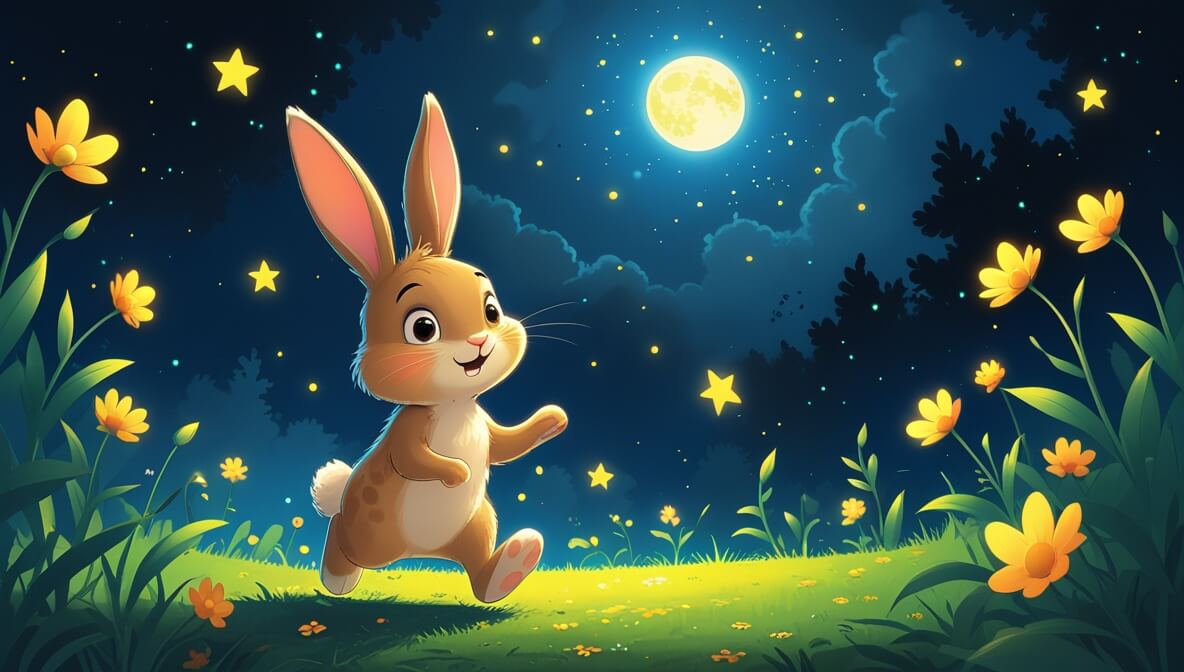In a world where dreams come alive, a little bunny named Bella and her friend, the magical moonbeam, discover the power of friendship and bedtime routines.
Age Recommendation
0 – 4 years
Characters
Characters:
- Bella the Bunny (a curious little bunny with floppy ears)
- Moonbeam (a gentle, glowing friend from the moon)
Story
Bella the Bunny loved to hop around her garden during the day. But when the sun began to set and the stars twinkled in the sky, she felt a little bit shy. She wondered what magical things happened in the nighttime.
The sparkly moonbeam
One night, as Bella lay in her cozy bed, a soft moonbeam appeared at her window. “Hello, Bella,” whispered the moonbeam, “Would you like to join me on a nighttime adventure?” Bella’s eyes widened with excitement.
A stroll under the stars
Bella hopped outside with the moonbeam by her side. The garden looked different at night. The flowers closed their petals, and the gentle whisper of the night filled the air. “Look, Bella,” said the moonbeam, “The stars are like friends watching over us.”
Bedtime magic
Bella felt happy and safe with the moonbeam. As they played, she realized that bedtime wasn’t scary at all. With a yawn, she said, “Thank you, moonbeam, for showing me the magic of the night.” The moonbeam smiled, “Goodnight, Bella. Sweet dreams await you.”
The end.
Moral of the Story
The story teaches that bedtime can be a magical time, full of comfort and friendship. Having a routine and a special friend can make nights feel safe and wonderful.
Questions to Think About
- Why did Bella feel shy about the nighttime at first?
- What did the moonbeam show Bella about the night?
- How did Bella feel after her adventure with the moonbeam?
- What makes your bedtime routine special?
- Who or what helps you feel safe at night?
Do You Know
- The moon reflects the sun’s light, which is why it glows bright in the night sky.
Word Explorer
- Moonbeam: A bright streak of light from the moon.
- Twinkle: To shine with flickering light.
- Whisper: To speak softly without much sound.
Emotions in the Story
- Curiosity: Bella felt curious about the night when the moonbeam invited her.
- Happiness: Bella felt happy discovering the magic of the night with her friend.
- Calmness: Bella felt calm and safe, knowing bedtime could be magical.
Color Your Scene
Imagine Bella and the moonbeam playing under the starry night sky. Draw Bella with her floppy ears and the glowing moonbeam lighting up the garden. Use dark blues for the sky and bright yellows for the stars and moonbeam.
Parents’ Corner
This story is a sweet way to share the joy of:
Bedtime routines: Discuss how having a comforting bedtime routine, like Bella’s adventure, can help your child feel secure and ready for sleep.
Imagination: Encourage your child to imagine their own bedtime adventures, sparking creativity and joy in the nighttime.
Friendship: Talk about how having a special friend, like the moonbeam, can make any moment magical.
Exploring emotions: Use Bella’s journey to explore feelings about the dark, showing that it’s okay to feel shy or curious.











